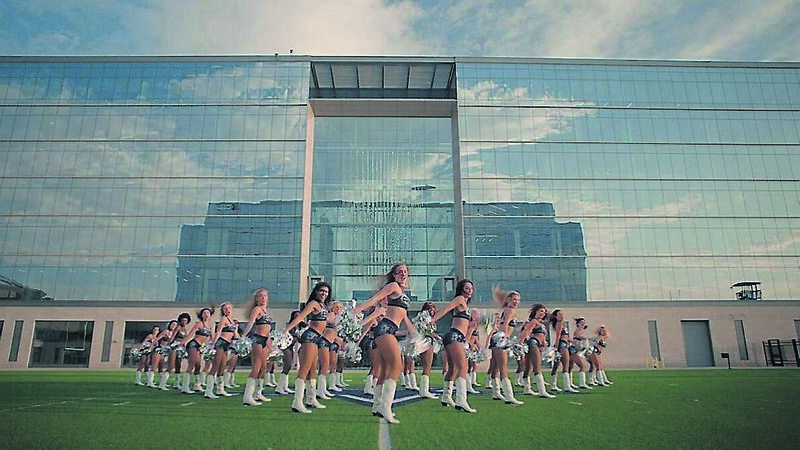Being a cheerleader sounds so glam... but reality is different

America’s Sweethearts: Dallas Cowboys Cheerleaders airs on Netflix now.
Talk about shock. Disappointment. Graphic reminders of toxic chauvinism.
I was so looking forward to watching the Netflix series America’s Sweethearts about the glamorous, iconic Dallas Cowboys Cheerleaders.
There’s a wonderful blue-and-silver carnival feel to these incredible high-kickin’ Amazonian dancers; rangy, tanned, beautiful, they ooze energy, flash huge white smiles and do jaw-dropping jump splits in tiny, glittering costumes – cropped, fringed vest, star-spangled hot-pants, ice-white cowboy boots - before mammoth roaring stadiums in quick-as-a-blink choreography.
Except that what I expected to be an upbeat inspirational story of female empowerment turned out to be a jaw-dropping revelation of grim exploitation, and, as they’d say in Texas, my bright expectant smile dimmed quicker than a rat up a drainpipe.
The Dallas Cowboys Cheerleaders is a crack team of 36 highly trained and disciplined dancers at the absolute pinnacle of their game - the crème de la crème of athleticism, skill, beauty, talent and unbeatable “x-factor”.
To be fair, high standards, strict discipline and rigorous training in a team like this is only to be expected.
But the revelation by one of the dancers that her salary was equivalent to that of a substitute teacher or a full-time Chick-Fil-A-worker left me agape - by comparison it's reported that the lowest-paid Dallas Cowboys player makes around €800,000 a year while highly rated NFL footballers can earn more than €50 million a year.
Many DC cheerleaders therefore juggle the physical and psychologically demanding lifestyle with full-on jobs as florists, nurses, dance instructors ( and I think there was a dentist as well.)
In one episode a dancer talks about her day; working as a nurse from 7.30am to 4.30p.m before attending DCC practice which can lasts ‘til midnight.
Dancers reportedly practice at least 20 hours a week on top of working on match days and making other appearances during the regular season plus training camps, additional programming in the off--season and so on.
I googled more.
The Dallas Cowboys organisation is reportedly valued at €9 billion and is believed to be the most valuable sporting organisation in the world.
Yet not only are these women reportedly quite poorly paid; they appear to be treated with open contempt by some footballers. I viewed more than one YouTube video which highlighted the disrespectful, boorish behaviour of some players who appear to roam at will around the pitch during pre-match cheerleader performances , crowding dancers in the middle of highly synchronised routines, doing warm-ups and flinging and kicking balls right next to them. I was appalled. Why are players even allowed on the pitch during the short cheerleading performances?
And why do the cameras cut away from cheerleader dance performances to show footage of male players who will dominate the pitch for the rest of the night?
Suddenly being a cheerleader didn't appear to be a particularly glamorous or even well-respected position within the Dallas Cowboys organisation at all.
In the Netflix series, a DC executive suggests cheerleaders are motivated not by money but by opportunity and a passion for dance. It’s about “sisterhood” the executive said; about “relationships”; it’s about a chance for them to find purpose and passion and feel valued and, er, special.
Being a DC cheerleader is a full-time, physically demanding, exhausting grind of a job which requires rigorous training and aesthetic upkeep and it’s all being passed off as a “privilege” for which they should be humbly grateful?
Would the DC try that on its male footballers?
I googled a bit more.
In one interview an anonymous dancer claims that the men on the practice squad who “don’t even touch the field half of the time” were getting €80,000 more a year than the seemingly almost-permanently-on-call cheerleaders.
I read that, unlike the footballers, the cheerleaders can’t use their titles to sign sponsorship deals or social media influencer agencies to supplement their incomes.
And here’s the part where my jaw really dropped. One of the cheerleaders’ most famous feats - and the Netflix series gives this issue some airing - is the jump split, a spectacular, highly skilled and formidable acrobatic movement that’s become a DC Cheerleaders’ signature.
The thing is, though, it’s widely reported that the jump split can be painful and a stressor on the body. This on top of the inevitably demanding physical regime must all take its toll.
One former cheerleader mentioned how she postponed reconstructive hip surgery to finish her final season and later had to have an additional procedure on her foot.
Another revealed she had had 12 orthopaedic surgeries in the last six years.
Another tore both her hips during her time as a cheerleader.
Another, who retired after finishing her final year with a neck and shoulder injury, commented that while being a DC cheerleader was prestigious, prestige doesn’t pay the rent.
My smile collapsed.
Lousy pay. Callous, public disrespect from colleagues. Injuries.
Suddenly the first bars of Thunderstruck were giving me cramps. Episode six features Dolly Parton performing her world-famous hit “9 to 5” at the half-time show during the Dallas Cowboys’ Thanksgiving game last autumn.
“Workin’ nine to five what a way to make a livin/Barely getting’ by, it’s all takin’ and no givin’/ Nine to five, yeah they got you where they want you…
Ironic, no? Written in 1980, those lyrics had a depressing resonance with what I’d just been watching.
It's 44 years since that song was written!
Tell me. What’s changed?







 App?
App?




